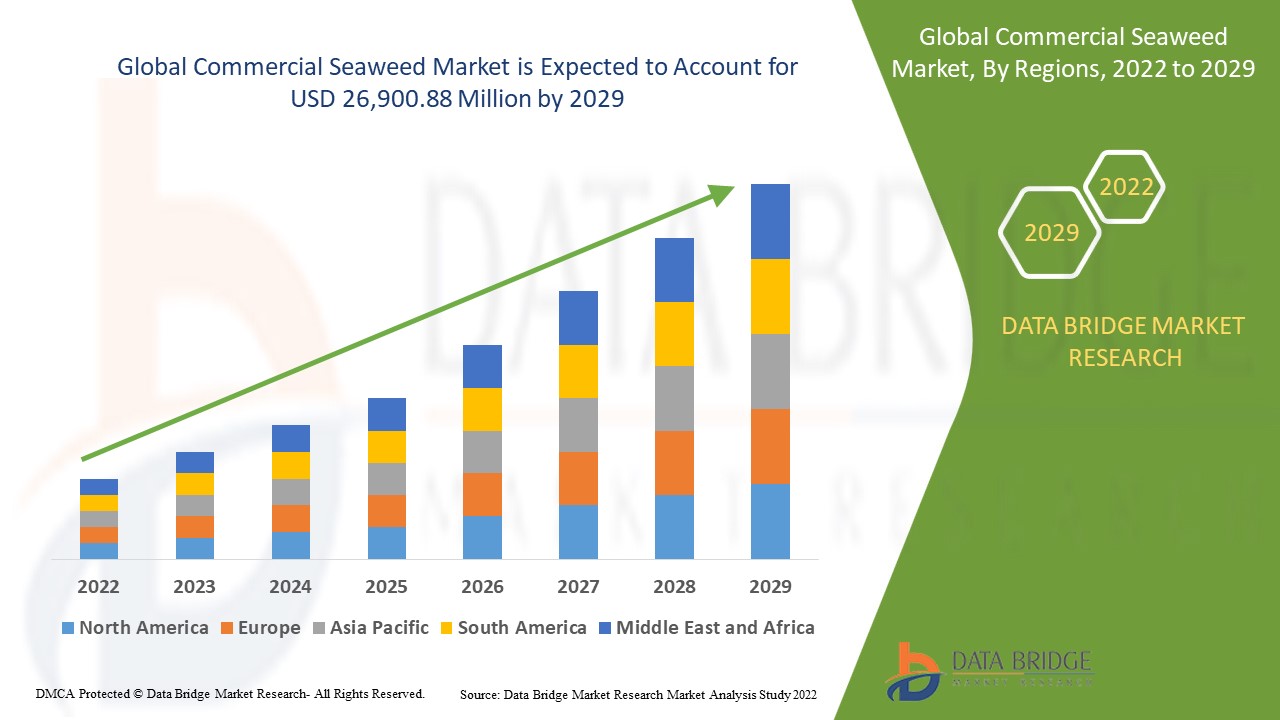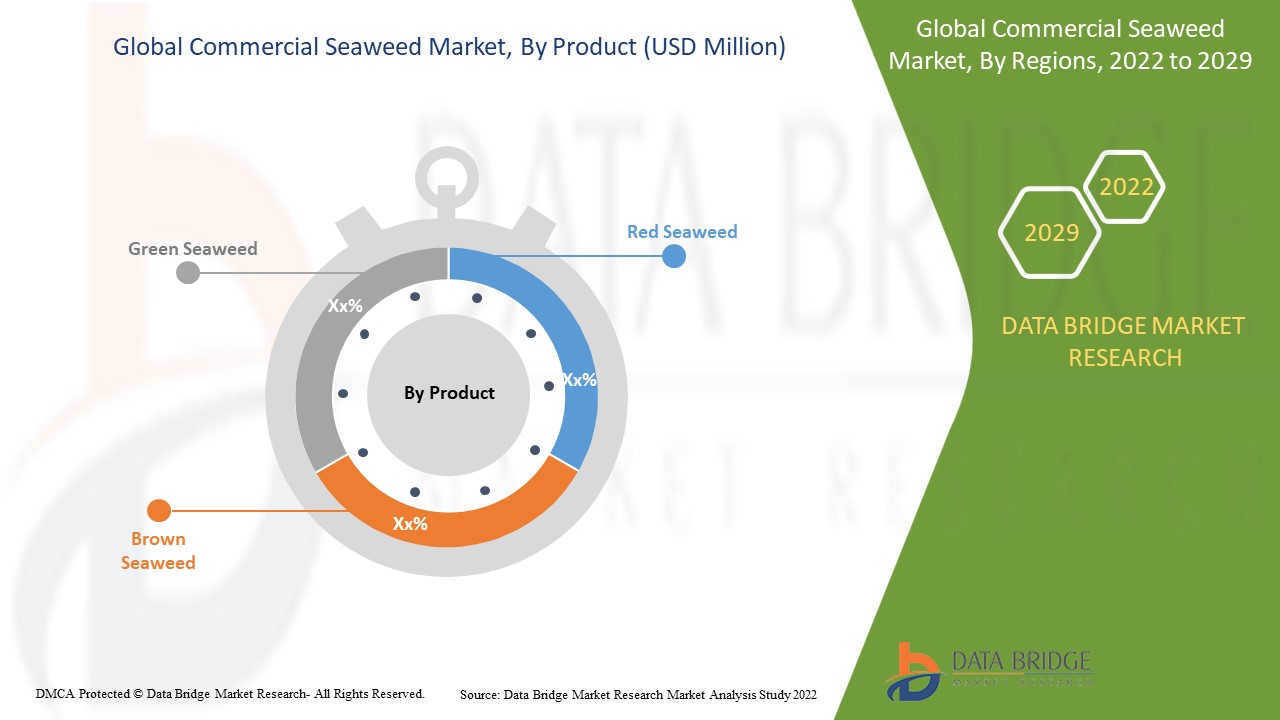Global Commercial Seaweed Market, By Product (Red Seaweed, Green Seaweed and Brown Seaweed), Form (Liquid, Powdered and Flakes), Cultivation (Onshore Cultivation, Offshore Cultivation, Nearshore Cultivation, IMTA Cultivation, Saline Aquaculture), End User (Food & Beverages, Pharmaceuticals, Agriculture, Animal Feed, Cosmetics & Personal Care, Biofuels and Others), Country (U.S., Canada, Mexico, Germany, U.K., Italy, France, Spain, Norway, Switzerland, Netherlands, Belgium, Russia, Turkey, rest of Europe, Japan, China, South Korea, India, Australia, Singapore, Thailand, Malaysia, Indonesia, Philippines, rest of Asia-Pacific, Brazil, Argentina, rest of South America, South Africa, UAE, Saudi Arabia, Kuwait, and rest of Middle East and Africa) Industry Trends and Forecast to 2029

Market Analysis and Insights: Global Commercial Seaweed Market

The global commercial seaweed market is expected to gain market growth in the forecast period of 2021 to 2029. Data Bridge Market Research analyses that the market is growing with the CAGR of 7.3% in the forecast period of 2022 to 2029 and expected to reach USD 26,900.88 million by 2029. The demand for the commercial seaweed are high hence revenue generation is also high which is helping the market to grow in the region.
Commercial seaweed is the microalgae that grow in the sea, irrespective of marine water or freshwater. They are the food source for life in the ocean and can be found in three colours red seaweed, green seaweed and brown seaweed based on the pigments present. Seaweeds grow mostly along the rocky shorelines all around the world. Commercial seaweed is an enriched source of proteins, vitamins, minerals, fibres, iodine and antioxidants. Additionally, commercial seaweed is known to provide health benefits such as decreasing the risk of heart disease, diabetes, and goitre and improving gut health.
Commercial seaweed is essential to fulfil the consumers' nutrition demand and reduce a certain disease's risk. Commercial seaweed helps to provide better yield quality and quantity in the agriculture sector, and fulfil the increasing demand for hydrocolloids in food & beverages industry as well as the cosmetics & personal care industry. Recent studies have also shown that commercial seaweed can fight against the COVID-19 virus, and it has a better effect than the existing vaccine. Thus, commercial seaweed is one of the important parameters. Many companies are expanding their manufacturing facilities to fulfil the higher demand for commercial seaweed products. Commercial seaweed market is gaining significant growth due to increase in adoption of seaweed for hydrocolloids, high nutritional value and health benefits of the seaweeds, and increasing demand for seaweed in various industries such as pharmaceuticals, personal care, agriculture, domestic, animal feed food & beverages & others worldwide. However, environmental risk associated with the seaweed and the high amount of iodine and heavy metals present in it are expected to restrain the market growth of commercial seaweeds during the forecasted period.
This global commercial seaweed market report provides details of market share, new developments, and product pipeline analysis, impact of domestic and localised market players, analyses opportunities in terms of emerging revenue pockets, changes in market regulations, product approvals, strategic decisions, product launches, geographical expansions, and technological innovations in the market. To understand the analysis and the market scenario contact us for an Analyst Brief, our team will help you create a revenue impact solution to achieve your desired goal.

Global Commercial Seaweed Market Scope and Market Size

The global commercial seaweed market is segmented into four notable segments which are based on by product, form, cultivation and end-user. The growth among segments helps you analyse niche pockets of growth and strategies to approach the market and determine your core application areas and the difference in your target markets.
- On the basis of product, the global commercial seaweed market is segmented into red seaweed, green seaweed and brown seaweed. In 2022, brown seaweed has the largest market share due to the factors such as increasing awareness about the health benefits offered by the brown seaweed and the rise in demand for more natural and organic products.
- On the basis of form, the global commercial seaweed market is segmented into liquid, powdered and flakes. In 2022, powder segment has the largest market share owing to the factors such as increasing awareness pertaining to the health benefits of the product made its way into various industries like food & beverages, pharmaceutical, agriculture and others.
- On the basis of cultivation, the global commercial seaweed market is segmented into onshore cultivation, offshore cultivation, nearshore cultivation, IMTA cultivation, saline aquaculture. In 2022, the offshore cultivation segment has the largest market share due to the factors such as rising demand for commercial seaweed and increased interest in growing seaweed on a large scale.
- On the basis of end-user, the global commercial seaweed market is segmented into food & beverages, pharmaceuticals, agriculture, animal feed, cosmetics & personal care, biofuels and others. In 2022, the food & beverages segment has the largest market share due to the factors such as increasing awareness about the nutrient enrichment and health benefits offered by the seaweed and a rise in demand for more natural and organic food and beverages products.
Global Commercial Seaweed Market Country Level Analysis
The global commercial seaweed market is analysed and market size information is provided by on by product, form, cultivation and end-user.
The regions covered in the global commercial seaweed market report are U.S., Canada, Mexico, Germany, U.K., Italy, France, Spain, Norway, Switzerland, Netherlands, Belgium, Russia, Turkey, rest of Europe, Japan, China, South Korea, India, Australia, Singapore, Thailand, Malaysia, Indonesia, Philippines, rest of Asia-Pacific, South Africa, UAE, Saudi Arabia, Kuwait, and rest of Middle East and Africa.
- In Asia-Pacific, China is expected hold highest market share as growing cultivation of the seaweed in the country and increase in demand of the seaweed across the end users. In Europe, France is expected to dominate the market as they are highly aware with the benefits of commercial seaweed. In North America, the U.S. is the highest market share due to increasing applications of seaweed in pharmaceutical and personal care industry.
The country section of the global commercial seaweed market report also provides individual market impacting factors and changes in regulation in the market domestically that impacts the current and future trends of the market. Data points such as new sales, replacement sales, country demographics, regulatory acts and import-export tariffs are some of the major pointers used to forecast the market scenario for individual countries. Also, presence and availability of global brands and their challenges faced due to large or scarce competition from local and domestic brands, impact of sales channels are considered while providing forecast analysis of the country data.
Growing Strategic Activities by Major Market Players to Enhance the Awareness for Commercial Seaweed is Boosting the Market Growth
The global commercial seaweed market also provides you with a detailed market analysis for every country's growth in a particular market. Additionally, it provides detailed information regarding the market players’ strategy and their geographical presence. The data is available for the historical period 2011 to 2020.
Competitive Landscape and Global Commercial Seaweed Market Share Analysis
The global commercial seaweed market competitive landscape provides details by the competitor. Details included are company overview, company financials, revenue generated, market potential, investment in research and development, new market initiatives, production sites and facilities, company strengths and weaknesses, product launch, product trials pipelines, product approvals, patents, product width, and breadth, application dominance, technology lifeline curve. The above data points are only related to the company’s focus on the global commercial seaweed market.
Some of the major players covered in the global commercial seaweed report are Cargill, Incorporated, DuPont, Marcel Carrageenan, AtSeNova, Beijing Leili Agricultural Co., Ltd, Pacific Harvest, Irish Seaweed, Ocean Rainforest, Indigrow Ltd, Seaweed Solutions AS, Maine Coast Sea Vegetables, Kelp Industries, Pty, Ltd., Organic Irish Seaweed-Emerald Isle, Green Ocean Farming UK, Nantong Xinlang Seaweed & Foods Co., Ltd., The Seaweed Company, Cascadia Seaweed, KwangcheonKim and Others. DBMR analysts understand competitive strengths and provide competitive analysis for each competitor separately.
For instance,
- In November 2021, Cascadia Seaweed partnered with Tsawout First Nation to farm seaweed off James Island. This helped the company to increase the production of seaweed in order to meet the growing demand for seaweeds
- In November 2021, Acadian SeaPlus launched new Chondracanthus chamissoi seaweed product to customers across the global market. It is a red algae species that has application in variety of products ranging from functional food, nutraceutical, cosmetics, pharmaceuticals, and brewing. This helped the company to expand their product portfolio
- In February 2019, According to Food and Beverages News, Cargill has launched a Red Seaweed Promise program to harvest and cultivate red seaweed in sustainable way to ensure long-term sustainable supply chain to support local communities and to conserve marine environment
SKU-

